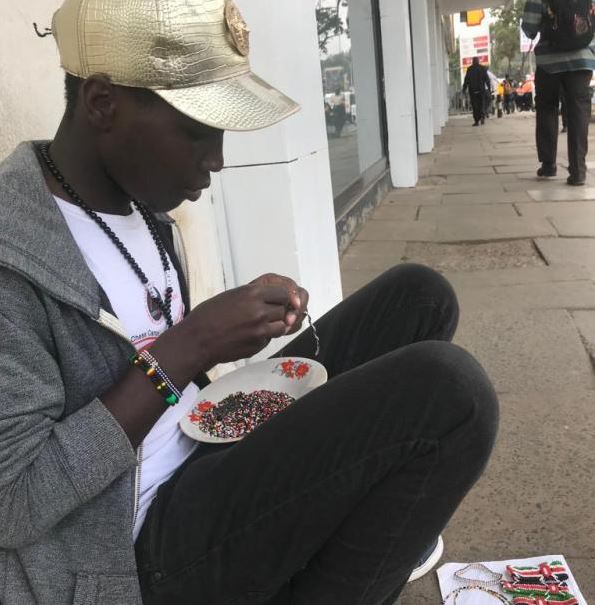
At the junction of University Way and Koinange Street, and overlooking the University of Nairobi, a young man sits on the ground all day.
He carries with him a bowl of beads and wristbands that he displays on a sheet of paper. He told me his name is Chris and he comes from Kilgoris. He’s self-taught in the art of making wristbands from beads, which he sources from downtown Nairobi. A wristband with your name on it will cost you Sh150, while a plain one costs Sh100.
He’s one of the loneliest hustlers in the city. He sits by himself all day on the street, selling about five bands daily. He looks to be around 20. He’s very patient.
Rarely do youngsters learn the old arts; these have been left to the elderly, which is why crocheting has slowly died, though mechanisation is also to blame. Beadwork seems to defy mechanisation. Most traditional necklaces, belts, headbands and wristbands are handmade.
It’s not clear why beads have such a deep connection to traditional societies. In my last visit to a Native American reservation, Choctaw in Mississippi, I was surprised to see beadwork very similar to what the Maasai of Kenya do. The Choctaws are one of the many Native American tribes, often called Red Indians. They were so fascinated by my Maasai belt that they picked me for a traditional dance!
Back to Kenya. The young man’s beadwork is a bold attempt to keep an old art going, and he’s doing it outside a university that symbolises modernism.
How many men of his generation can make such items? How many young men and women can sew, crochet or make a mwiko?
Matter of concern
It’s a matter of concern: why have arts that have been there for thousands of years been allowed to die under our watch? Will the competency-based curriculum teach arts and crafts again? What will happen to such arts as we progress? What will happen to Maasai belts? The Maasai shuka has got global recognition and should be declared our national dress. What of other artefacts from Kenya’s many communities? Are the curios sold to wazungus enough?
There’s something sentimental in our traditional arts despite all the modernity. Chris is playing his small role in preserving these arts. It seems the easiest way to preserve them is to make money from them. I was mesmerised to see a wine glass with a handle covered in beads.
After Maasai market and young Chris, we need other community markets, from El Molo to Kamba, Taita and others. Will this be led by the invisible hand of the market or the visible hand of Government?
The loneliest hustler should get company. Will you join him?
[XN Iraki; [email protected]]
 The Standard Group Plc is a multi-media organization with investments in media
platforms spanning newspaper print operations, television, radio broadcasting,
digital and online services. The Standard Group is recognized as a leading
multi-media house in Kenya with a key influence in matters of national and
international interest.
The Standard Group Plc is a multi-media organization with investments in media
platforms spanning newspaper print operations, television, radio broadcasting,
digital and online services. The Standard Group is recognized as a leading
multi-media house in Kenya with a key influence in matters of national and
international interest.
 The Standard Group Plc is a multi-media organization with investments in media
platforms spanning newspaper print operations, television, radio broadcasting,
digital and online services. The Standard Group is recognized as a leading
multi-media house in Kenya with a key influence in matters of national and
international interest.
The Standard Group Plc is a multi-media organization with investments in media
platforms spanning newspaper print operations, television, radio broadcasting,
digital and online services. The Standard Group is recognized as a leading
multi-media house in Kenya with a key influence in matters of national and
international interest.










